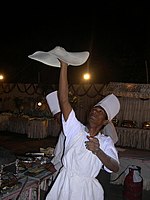Manda roti
This article needs additional citations for verification. (December 2018) |
 Manda roti being prepared in India on an upturned vessel | |
| Alternative names | Mandige, rumali, or veechu roti |
|---|---|
| Place of origin | |
| Associated cuisine | Indian and Pakistani |
| Main ingredients | Atta and maida flour |
Manda roti (also called rumali roti) is a traditional Indian and Pakistani bread. They can be made with cardamom, ghee, sugar and milk. This roti is extremely thin and limp, and served folded like a handkerchief. Manda roti is usually made with a combination of whole-wheat atta flour and white wheaten maida flour and cooked on the convex side of a kadahi. It is also known as veechu roti in Tamil or mandige[1] in other parts of South India.
Etymology and history
[edit]The word manda roti is a compound of two words: manda and roti. The word manda is derived from the Sanskrit word maṇḍaka and roti from the Sanskrit word roṭikā. Maṇḍaka is a wheat-based flatbread mentioned in Sanskrit literature from religious scriptures like Skanda purāṇa to Pākakalā texts like Bhojanakutūhala. As per Skanda purāṇa, maṇḍaka are thin circular symmetrical flat cakes prepared from wheat flour. In Bhojanakutūhala, the detailed recipe of maṇḍaka describes that they are cooked on an upturned pot.[2] In Madanapala Nighantu, several varieties of mandakas are mentioned which are prepared by adding vikola, karkaṭa, drākṣā and kantakäri, among other ingredients.[3][4]
-
A chef preparing manda roti
-
Manda roti
References
[edit]- ^ Sinha, Anil Kishore (2000). Anthropology of Sweetmeats. Gyan Publishing House. ISBN 978-81-212-0665-5.
Mandige or mandage was a delicate baked product; when baked on a heated tile (Kenchu). It was called white-mandige, and when over - heated but still very soft it was ushnavarta-mandige,...
- ^ www.wisdomlib.org (14 August 2014). "Mandaka, Maṇḍaka, Mandāka, Mamdaka: 22 definitions". www.wisdomlib.org. Retrieved 4 May 2023.
Maṇḍaka (मण्डक) refers to a "thin flat circular cake-like dish" and is mentioned in the Skandapurāņa 2.5.9... Maṇḍaka (मण्डक) is the name of "wheat dish" having Samita as its base ingredient, as described in the 17th century Bhojanakutūjala... Cook these on an upturned pot in low flame. This is called maņdaka.
- ^ Dash, Vaidya Bhagwan (August 2002). Materia Medica of Ayurveda: Based on: Madanapala's Nighantu (in Hindi). B. Jain Publishers. ISBN 978-81-7021-493-9.
Mandaka (a type of pastry) Among the mandaka etc., cooked by adding vikola, karkaṭa, drākșā and kantakāri, the former ones are heavier and more nourishing than the latter ones. Mandaka is fried over an earthen pan
- ^ Achaya K. T. (1994). Indian Food Tradition A Historical Companion. ISBN 978-0-19-562845-6. Retrieved 31 January 2019.






